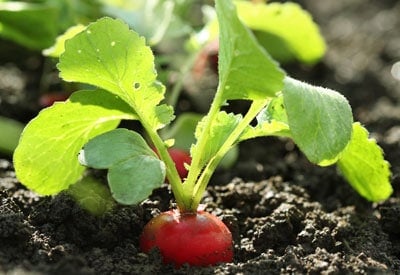That short season of spring-harvest garden vegetables is almost — or entirely — gone depending on where you live. Some are yet to come. Here, a week before the official start of summer, our peas are full of blossoms. Pea blossoms make a lovely addition, when still attached to their curling tendrils, to any salad or as a garnish. But peas themselves, one of the first things planted in the garden and one of the first we think to harvest, are still a few days away.
And sure, we’ve been harvesting lettuce — we were thinning it a week ago — and we know its young, fresh flavor won’t be matched by what we pick in July. But the lettuce proves the point: some of our favorite garden harvests come during spring.
Maybe the reason these early season garden crops seem so delicious, and satisfying, and even precious, is that they are the first. Later when the carrots and tomatoes and the summer squash comes, we may have forgotten all about them (unless there’s some rhubarb sauce in the freezer). But for now, they’re the most wonderful harvest we can imagine.
Down-To-Earth® Bio-Live Fertilizer combines a special mix of plant nutrition with beneficial bacteria and mycorrhizal fungi to make sure your plants are covered from leaf tip to root hair. Apply 5 lbs per 100 square feet and thoroughly mix into soil.
You know the crops we mean: asparagus, rhubarb, and green onions and garlic; tops from root vegetables like beets and turnips some herbs like sorrel. Early spinach and kale that over-wintered. The abundance of early, especially healthful and exceptionally delicious greens keep going for only a brief time with rhubarb crisp and roast asparagus, small delicate salads, and omelets with bits of tender garlic scallions.
The garlic “scallions” are a prime example of a spring-only harvest. They come very early to those who plant them in the fall. But even those of us who, because of weather or laziness, plant blubs as soon in spring as the ground dries out, eventually get them, though they toughen up quickly the later into the season it gets.
Joe Eck and Wayne Winterrowd, in their excellent book To Eat: A Country Life claim to grow garlic only for the tops. They (Wayne died in 2010) not only used them in omelets, but in cream sauces and in stews of chicken or veal, or with any kind of fish. They mashed up the shoots with a mortar and pestle along with some unsalted butter for a “gentle” spread which sounds like it would be super slathered on good country bread and toasted or grilled. (Eck and Winterrowd didn’t bother to grow garlic bulbs because they take too much space that could be used for other things in the garden and they can get locally-ground, organic heads at their Farmers Market.)
Nowadays, the curling tops of garlic shoots are called scapes. They can be a little tougher than just the shoots — some experts say the should be picked ahead of their curling, but they take well to stir-frying. At some point we have to give up cutting shoots and scapes from our plants so that our garlic bulbs — we definitely grow them — will have enough green plant above the soil line to prosper. The don’t need many. Same if you’re trimming onion tops for greens. You want to pick onion shoots especially early. They seem to get tougher and stronger flavored more quickly than gardenscapes.
The asparagus patch is throwing up its tall, thin tangles of tendrils now, though we’re still getting a stalk freshly broken through the ground here and there. If you don’t have asparagus, now’s the time to plant. Our harvest was pretty good this year — must have been the moisture — and we’ve really enjoyed roasting the spears in a hot oven or even chopping them up and stir frying them.

There’s plenty of advice out there on how to start a fresh patch. We’ve learned from previously failures to mix in a bunch of sand where your patch will be and otherwise make sure the soil has good and deep drainage. I also didn’t have luck trying to transplant asparagus I’d started indoors. Best, and most simple, to buy crown and plant them to instruction. Don’t forget: the crown need to be planted deeply, some six to eight inches. Also give them plenty of room, at least 15 to 18 inches apart.
Our favorite spring-harvest vegetable is rhubarb. Now we’re not one of those people that think you need a lot of sugar to make rhubarb edible. The thing that makes rhubarb sweet for us is that’s its rich in memories. Grandma’s rhubarb crisp, Susan’s rhubarb pie with the homemade crust, mom’s rhubarb sauce (okay, that had lots of sugar, the way mom liked it). Those dishes still call from the past.
Now’s a good time to plant rhubarb (PDF), just before summer really gets going. Plant from cuttings — I’ll bet you can get some from the neighbor — that include part of the crown and at least one visible leaf bud. Rhubarb is a perennial, like asparagus. Once you get it going, it will be around for years if you keep it well fed. If you are keeping it well fed and it’s started to put out those skinny little stalks that nobody likes, it might be time to dig up that old plant — age is the second biggest factor in causing skinny rhubarb stalks — and put in some new. But don’t waste even the skinny stalks. Sour cream rhubarb squares, anyone?











